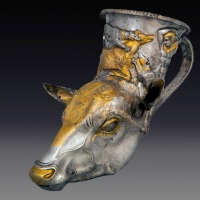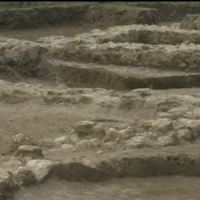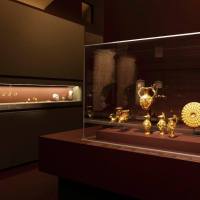
The Ancient Theater is perhaps the most emblematic landmark of Bulgaria’s Plovdiv, which is said to be Europe’s oldest city. Photo: Edal, Wikipedia
Bulgaria’s Ministry of Culture and the southern Plovdiv Municipality have signed a grant contract for the “digitization”, i.e. filming, photographing, 3D presentation, and web publication of Plovdiv’s archaeological and historical heritage with funding provided from the European Economic Area (EEA) and Norway Grants mechanism.
The grant contract for a total of EUR 740,000 for the “digitization” of some 50,000 archaeological and historical monuments and individual artifacts has been signed by Plovdiv Mayor Ivan Totev, Plovdiv Municipality has announced.
The grant is provided from the EEA/Norway Grants mechanism under a measure for the restoration, rehabilitation, and preservation of cultural heritage.
The digital database to be created with the funding will feature archaeological sites and excavations, historical monuments, books, sculptures and art works, and artifacts.
“Such large-scale digitization of the cultural heritage will be undertaken for the first time in Plovdiv Municipality,” Mayor Ivan Totev is quoted as saying, adding that modern 3D scanners and other equipment will be purchased as part of the project.
“The digitization will be carried out in two major ways – through the two digital centers and four mobile digital stations that will be created as part of the project, and through a unique ethnographic expedition. Special software presenting the items will also be developed. Gradually, the entire database will be uploaded into the digital library Europeana, thus advertising our city’s heritage,” Totev explains.
The EEA/Norway-funded cultural heritage project will be completed in 13 months by Plovdiv Municipality in cooperation with Regional National Library “Ivan Vazov” in Plovdiv, Plovdiv Regional Museum of History, Plovdiv Regional Museum of Archaeology, Plovdiv Regional Museum of Ethnography, the Ancient Plovdiv Municipal Institute, and the Plovdiv City Gallery of Art.
Plovdiv Mayor Ivan Totev has thanked all institutions that have come together for preparing the cultural heritage digitization project that has won the funding from the EEA and Norway Grants.
In addition to Plovdiv, the northern Bulgarian town of Tutrakan has also won an EEA/Norway grant of EUR 250,000 for the “digitization” of its archaeological heritage, including the Ancient Roman fortress Transmarisca on the Danube.
An EEA/Norway grant worth EUR 748,000 has also been provided recently to Kardzhali Municipality in Southern Bulgaria for the partial restoration of the acropolis of the ancient and medieval rock city and fortress of Perperikon.
Another EEA/Norway grant worth EUR 736,000 has been provided recently to Pavlikeni Municipality in Northern Bulgarian for the restoration of an Ancient Roman ceramic factory at a Roman military veteran’s villa estate.
Background Infonotes:
The history of today’s Bulgarian city of Plovdiv began on the ancient hill of Nebet Tepe (“tepe” is the Turkish word for “hill”), one of the seven historic hills where it was founded and developed in prehistoric and ancient times. The hills, or “tepeta”, are still known today by their Turkish names from the Ottoman period. Out of all of them, Nebet Tepe has the earliest traces of civilized life dating back to the 6th millennium BC, which makes Plovdiv 8,000 years old, and allegedly the oldest city in Europe. Around 1200 BC, the prehistoric settlement on Nebet Tepe was transformed into the Ancient Thracian city of Eumolpia, also known as Pulpudeva, inhabited by the powerful Ancient Thracian tribe Bessi. During the Early Antiquity period Eumolpia / Pulpudeva grew to encompass the two nearby hills (Dzhambaz Tepe and Taxim Tepe known together with Nebet Tepe as “The Three Hills”) as well, with the oldest settlement on Nebet Tepe becoming the citadel of the city acropolis.
In 342 BC, the Thracian city of Eumolpia / Pulpudeva was conquered by King Philip II of Macedon renaming the city to Philippopolis. Philippopolis developed further as a major urban center during the Hellenistic period after the collapse of Alexander the Great’s Empire. In the 1st century AD, more precisely in 46 AD, Ancient Thrace was annexed by the Roman Empire making Philippopolis the major city in the Ancient Roman province of Thrace. This is the period when the city expanded further into the plain around The Three Hills. Because of the large scale public construction works during the period of Ancient Rome’s Flavian Dynasty (69-96 AD, including Emperor Vespasian (r. 69-79 AD), Emperor Titus (r. 79-81 AD), Emperor Domitian (r. 81-96 AD)), Plovdiv was also known as Flavia Philippopolis. Later emerging as a major Early Byzantine city, Plovdiv was conquered for the First Bulgarian Empire (632/680 – 1018 AD) by Khan (or Kanas) Krum (r. 803-814 AD) in 812 AD but was permanently incorporated into Bulgaria under Khan (or Kanas) Malamir (r. 831-836 AD) in 834 AD. In Old Bulgarian (also known today as Church Slavonic), the city’s name was recorded as Papaldin, Paldin, and Pladin, and later Plavdiv from which today’s name Plovdiv originated. The Nebet Tepe fortress continued to be an important part of the city’s fortifications until the 14th century when the Second Bulgarian Empire (1185-1396 AD) was conquered by the Ottoman Turks. During the period the Ottoman yoke (1396-1878/1912) when Bulgaria was part of the Ottoman Empire, Plovdiv was called Filibe in Turkish.
Today the prehistoric, ancient, and medieval settlement on Nebet Tepe has been recognized as the Nebet Tepe Archaeological Preserve. Some of the unique archaeological finds from Nebet Tepe include an ancient secret tunnel which, according to legends, was used by Apostle Paul (even though it has been dated to the reign of Byzantine Emperor Justinian I the Great (r. 527-565 AD)) and large scale water storage reservoirs used during sieges, one of them with an impressive volume of 300,000 liters. Still preserved today are parts of the western fortress wall with a rectangular tower from the Antiquity period.












